4.9 Rating
Google REVIEWS
Leaders in Georgia Personal Injury Law Since 1995
Car Accident Arm & Leg Injuries
Suffered an arm or leg injury in a car accident? Understanding the type of injury, treatment, and steps to recovery is essential. This article explains car accident arm leg injuries, explores how they are diagnosed and treated, and offers insight into the rehabilitation process with the help of Scholle Law Car & Truck Accident Attorneys.
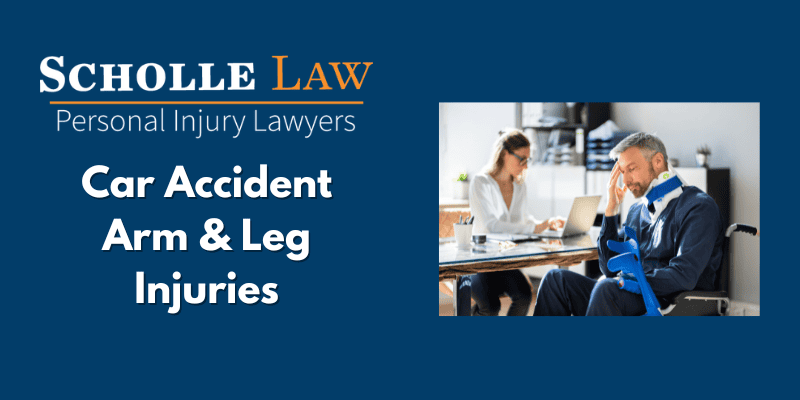
Key Takeaways
- Car accidents frequently lead to arm and leg injuries such as fractures, dislocations, ligament tears, and soft tissue damage due to direct impacts and indirect forces.
- Prompt medical treatment, thorough physical examination, and the use of diagnostic imaging like X-rays and MRIs are essential for the correct diagnosis and effective treatment of arm and leg injuries from car accidents.
- Victims of car accidents with arm or leg injuries may be entitled to compensation and should consider legal options such as filing a personal injury lawsuit or claim, with insurance coverage playing a key role in the process.
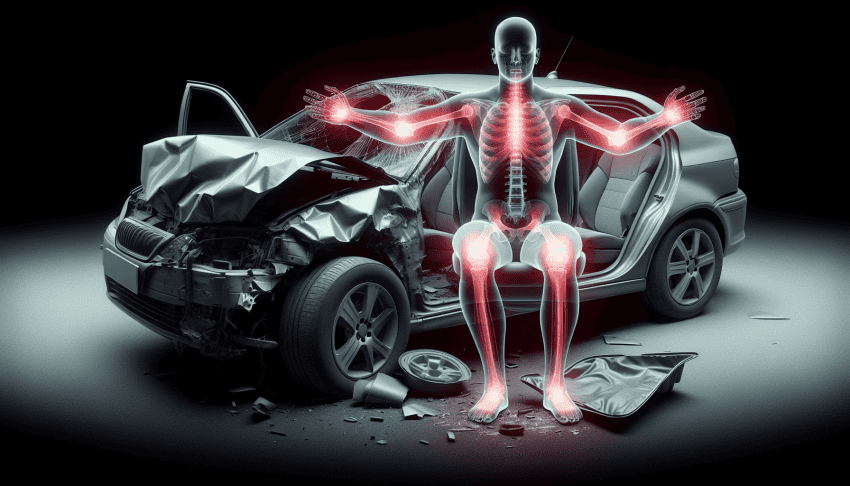
Arm and Leg Injuries in Car Accidents
In the event of a car accident, individuals frequently sustain injuries to their limbs. The nature and extent of these injuries are influenced by the intensity of forces involved in the crash, which can cause harm either through direct collision or as a result of secondary movements such as jerking or forceful stopping. How passengers are seated at the time impacts how serious their arm and leg injuries might be.
The arms and legs are particularly vulnerable during car accidents because unlike other parts of the body, they typically do not have restraints. Consequently, during an accident’s violent motions, these extremities may flail wildly leading to various types of trauma including:
- bone fractures
- hand, wrist and arm damage
- ligament tears
- joint dislocations
- tendon disruptions
This highlights broken bones and dislocated joints as some common consequences from car accident injuries involving limbs.
Direct Impact Injuries
Severe injuries can arise from direct impacts during car accidents. Fractures happen when the bone is overwhelmed by a force greater than it can withstand, often resulting from the body hitting parts of the interior like the steering wheel or dashboard. Broken wrists, arms, or shoulders are typical examples of arm and leg injuries caused by such significant forces upon collision.
In cases where individuals are not secured with seat belts, ejection injuries may occur due to being thrown out of the vehicle. These events can lead to broken bones upon striking either the ground or surrounding objects. Injuries sustained from these direct impacts vary in severity, but some collisions exert enough power to cause an array of serious arm and leg injuries.
Indirect Injuries
In car accidents, various arm and leg injuries can arise from indirect forces such as sudden movements or twisting motions. Injuries that frequently occur are:
- Bone fractures
- Joint dislocations
- Sprains and muscular strains
- Muscle ruptures
- Damage to ligaments
When a body suddenly stops during a car accident, the resulting acceleration injury may inflict serious trauma like fractures due to high impact forces. It’s crucial to seek medical care if your arms or legs hurt after being involved in an auto collision.
Whiplash is known as the most prevalent type of injury from car accidents. It can result in arm pain by stretching nerves within the brachial plexus too far. This causes discomfort extending into arms, wrists, and hands. Whiplash might involve shoulder and collarbone breaks because of abrupt head and neck motion during an incident.
Types of Arm and Leg Injuries
Injuries to the arms and legs sustained during car accidents may vary widely in severity, with potential outcomes ranging from relatively minor damage to serious harm. Depending on how the impact is delivered in terms of strength and angle, various kinds of injuries can manifest. Such damages often include broken bones (fractures), dislocated joints, torn ligaments, and injuries affecting soft tissue. In high-impact scenarios like vehicle collisions, fractures occur when a bone is subjected to force beyond its capacity.
Bones within the arm and leg regions are particularly susceptible to breaks or fractures resulting from vehicular accident-related trauma. It’s imperative for medical professionals to accurately diagnose these types of injuries so that effective treatment plans can be devised for those who have suffered leg or arm trauma due to an automobile incident.
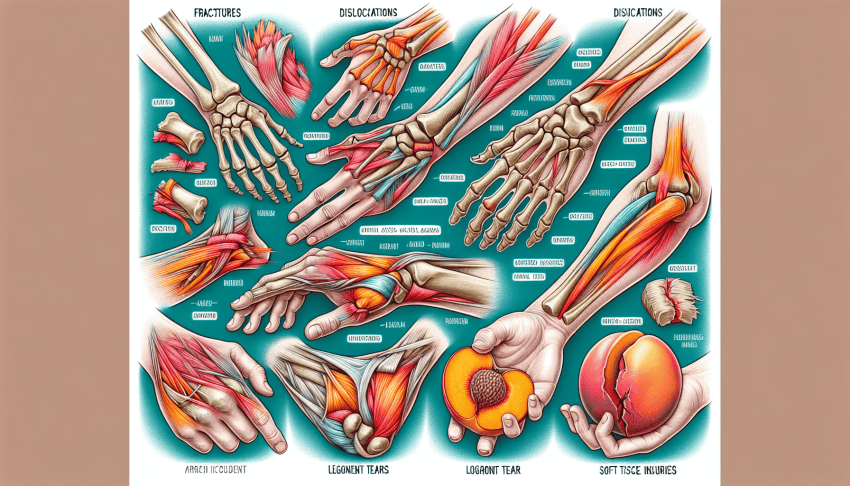
Fractures
Fractures frequently result from car accidents, with one often occurring injury being a collarbone break. Car accident trauma can cause several types of fractures in the arm, such as:
- Open fractures
- Comminuted fractures
- Intra-articular fractures
- Monteggia fractures
- Galeazzi Fractures
-Supracondylar humerus fractures
-scaphoid fractures and compression fracture
Leg injuries are particularly prevalent in frontal car collisions. These incidents tend to lead to substantial costs due to harm caused not only to the legs but also more specifically regions like the bony pelvis and upper leg on the side impacted by collision severity varies widely with some cases presenting minor hairline is key comminution bone armsolution leg.
Dislocations
A joint dislocation occurs when the bones that create a joint are violently forced apart, which is commonly caused by the trauma experienced in car accidents. The stability of the affected joint may be compromised, potentially resulting in Injuries such as severe tendon damage, ligament ruptures, bone fractures and nerve damage.
For example, it’s not unusual for individuals involved in car accidents to sustain elbow injuries like those associated with radial head disruptions which can trigger Harm.
The intense forces exerted during a car accident have the capacity to cause separation of joints and subsequent extensive injury. These traumatic outcomes often lead to acute pain and discomfort requiring significant medical treatment for proper recovery.
Ligament Tears
Car accidents can lead to ligament tears, which occur when a joint is overstretched or twisted. This type of injury results in symptoms like pain, swelling, bruising, and a lack of stability in the affected area.
One example of such an injury is damage to the medial collateral ligament (MCL), located at the knee. It constitutes one form of specific ligament injuries that may arise from vehicular incidents.
Injuries involving torn ligaments are usually painful and require an extensive period of healing. To achieve complete recovery from these conditions often necessitates rehabilitation measures including consistent physical therapy sessions.
Soft Tissue Injuries
Injuries to soft tissue resulting from automobile collisions can involve harm to the skin, connective tissues, adipose tissue, tendons, blood vessels, ligaments and muscles. Sprains—which entail the overstretching or tearing of ligaments—and strains—pertaining to injuries that affect either muscles or the attachments between muscle and bone—are among the most frequent forms of soft tissue damage in vehicle accidents.
For treating such injuries commonly incurred during car incidents, measures may include:
- Resting
- Applying ice
- Employing minimally invasive techniques
- Conducting more complex medical interventions if necessitated by the gravity of the injury
Timely detection and appropriate care are crucial for all types of traumas received in automotive crashes — this is true for spinal cord damages as well — with early treatment being vital to a positive healing process.
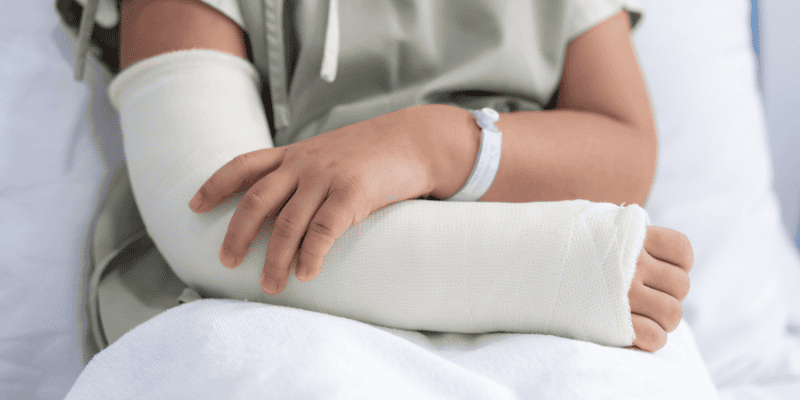
Diagnosis and Treatment of Arm and Leg Injuries
It is crucial to obtain medical treatment as soon as possible after a car accident in order to improve the chances of recuperating from injuries incurred. The quicker victims receive care, the more likely they are to have positive recovery outcomes. It’s imperative that individuals involved in a car crash seek immediate medical attention for an accurate assessment and management of their injuries. Ensuring quick emergency response for wounds like lacerations sustained during the accident can prevent small issues from escalating into serious health complications.
For arm injuries resulting from such incidents, securing an early diagnosis and appropriate treatment plan greatly enhances prospects for complete healing. Postponing medical care for any arm damage not only worsens the condition, but could also invite problems that may negatively affect mobility.
Diagnostic Methods
For most arm injuries resulting from car accidents, a detailed diagnosis is essential. The first step in the diagnostic process involves an extensive physical examination to determine both the severity and type of injury incurred.
Following the physical evaluation, imaging methods like X-rays and Magnetic Resonance Imaging (MRI) are utilized for precise confirmation of the injury as well as outlining its particular characteristics. These imaging modalities offer a definitive view of the damage, which facilitates a more exacting diagnosis and informed treatment strategy.
Treatment Options
Depending on the injury’s severity, treatment options for arm and leg injuries can range widely. These treatments may include simple measures such as:
- Resting and applying ice to reduce swelling
- Compression using a brace or bandage to support the injured area
- Keeping the limb elevated to decrease fluid buildup
- Engaging in physical therapy exercises to enhance mobility
- Taking over-the-counter pain relievers like acetaminophen or nonsteroidal anti-inflammatory drugs (NSAIDs) according to recommended guidelines
These methods are designed for temporary mitigation of pain from leg injuries and should be used by following proper dosages. Elevating an injured leg above heart level is beneficial in reducing swelling and supporting recovery.
For conditions that are less severe, such as shoulder impingement or those not requiring urgent surgical intervention, more conservative approaches take precedence. In cases of fractures, casts can immobilize bones keeping them properly aligned throughout healing processes. While pain medication aids in managing discomfort stemming from both arm and leg trauma. It doesn’t facilitate bone repair itself.
In circumstances involving significant harm, especially when other interventions prove inadequate, surgery might become essential, specifically with broken arms where restoring function necessitates precise reconstruction efforts.
Recovery and Rehabilitation
The healing process from arm and leg injuries necessitates a careful blend of:
- Adequate rest
- Subtle activity
- Consistent physical therapy
- Proper care at home
Ensuring a balance between resting adequately to prevent undue strain and engaging in soft movements is essential for proper healing. Gentle stretching exercises and activities that promote the range of motion are important to retain suppleness in the arms and legs, avoiding rigidity as they heal.
Adhering strictly to medical advice is imperative for a secure recovery after experiencing a car accident. Effectively controlling discomfort plays an integral role throughout the recuperation journey involving rehabilitation from these injuries.
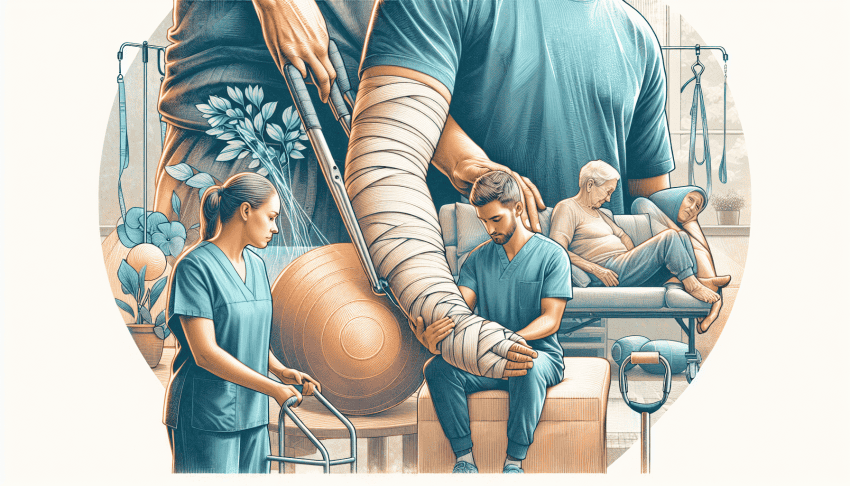
Physical Therapy
After sustaining arm and leg injuries in a car accident, engaging in physical therapy is essential for recovery. This form of treatment aids in alleviating discomfort, enhancing movement capability, and fortifying the muscles surrounding the fracture site.
The approach to physical therapy encompasses various techniques like:
- Tailored exercise routines
- Flexibility-enhancing stretches
- Hands-on manipulation
- Treatments using temperature-based interventions such as heating pads or ice packs
Commitment to a prescribed regimen of physical therapy, coupled with sufficient rest and refraining from overexerting the injured limb(s), can significantly reduce the healing time needed following an arm or leg injury caused by a vehicular collision.
Home Care
Proper home management is crucial to the healing journey for arm and leg injuries. Over-the-counter pain medications, such as acetaminophen or nonsteroidal anti-inflammatory drugs (NSAIDs), can provide short-term relief from discomfort in the legs when used within their prescribed dosages. Elevating the afflicted leg above the heart level is beneficial for reducing fluid buildup and enhancing recovery.
For both arm and leg injuries, employing strategies like administering pain relief medicine, keeping the injured extremity elevated, and adhering to medical advice are key components of effective home care. This approach greatly contributes to a successful recuperation process by optimizing healing outcomes.
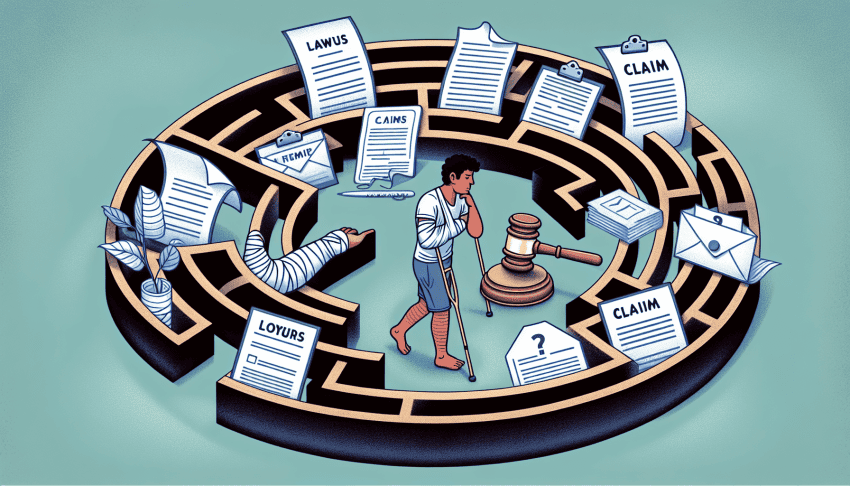
Seeking Compensation for Arm and Leg Injuries
Individuals who experience arm or leg injuries as a result of car accidents could be eligible for financial recompense. In the event of serious car incidents leading to such substantial injuries, consulting with an attorney from Scholle Law Car & Truck Accident Attorneys is recommended in order to negotiate a favorable settlement. Our adept car accident attorneys are prepared to assess your situation free of charge and focus on assisting victims in obtaining compensation for their injuries.
Securing legal guidance from one of our proficient attorneys can prove invaluable for those who have sustained arm or leg injuries due to car accidents. When insurance falls short in covering medical costs associated with these injuries, it’s wise to engage with a lawyer at Scholle Law to explore additional options and understand Actions that may be taken.
Legal Options
Individuals who suffer arm or leg injuries in car accidents may consider filing a personal injury lawsuit against the responsible party. Such lawsuits for accident injuries typically require proving that the other individual involved was negligent.
Should victims choose to pursue compensation through a personal injury lawsuit, they might receive it as structured settlements, which are payments distributed over an extended period. An alternative method is to file a personal injury claim where one negotiates directly with the insurance company of the liable party. If negotiations do not result in fair compensation, initiating a lawsuit remains an option.
In both scenarios—whether pursuing claims or lawsuits—the injured parties can work with Scholle Law to seek damages covering medical costs, loss of income due to inability to work, and emotional distress caused by their accident injuries.
Insurance Coverage
Settlements for arm and leg injuries resulting from car accidents are often affected by the specified limits of insurance policies that cover these types of injuries. Knowing the details of your insurance coverage is critical, as it plays a significant role in determining the compensation you can obtain for your arm and leg injuries.
At Scholle Law, our attorneys prioritize conducting comprehensive investigations into all possible avenues of insurance coverage available to clients who have suffered such injuries. It’s not the responsibility of opposing legal teams to disclose how much coverage you deserve. This responsibility falls on your lawyer. A deep understanding of your own insurance policy is essential when seeking to maximize the amount you receive in compensation.
Summary
To recap, arm and leg injuries from car accidents can range from fractures and dislocations to ligament tears and soft tissue injuries. These injuries can occur from both direct impacts and indirect forces such as twisting or sudden deceleration. Prompt medical attention and proper diagnosis are crucial for treatment and recovery, which may involve physical therapy and home care. Victims of such accidents may be entitled to compensation, and it’s important to work with Scholle Law to explore all legal and insurance options. Stay safe on the roads, and remember, your health and wellbeing are always the top priority.
Frequently Asked Questions
What are the common types of arm and leg injuries from car accidents?
Injuries to the arm and leg resulting from car accidents frequently involve broken bones, joint dislocations, tears in ligaments, and damage to soft tissues. The severity of these injuries can vary greatly and often necessitate prompt medical attention.
Why is immediate medical attention important after a car accident?
Receiving medical attention immediately following a car accident is essential for the appropriate treatment and assessment of any sustained injuries, as well as to avoid minor injuries escalating into more severe issues.
What role does physical therapy play in recovery from car accident injuries?
Rehabilitation from injuries sustained in a car accident is significantly enhanced through physical therapy, which serves to alleviate pain, boost mobility, and fortify muscles, thereby accelerating the healing process.
How can one seek compensation for arm and leg injuries from car accidents?
If you have sustained arm and leg injuries due to car accidents, it’s recommended that you pursue a personal injury claim or lawsuit for compensation. It is also beneficial to examine your insurance policy coverage in this situation. For assistance throughout the process, consulting with a knowledgeable attorney can be invaluable.
What is the importance of understanding your insurance coverage in the compensation process?
Grasping the specifics of your insurance policy is vital as it influences the compensation level you might obtain for any injuries sustained.
The settlement that one can anticipate largely hinges on the designated policy limits set aside for injury claims.
